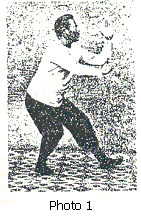 |
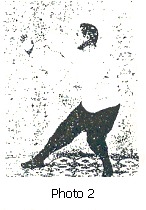 |
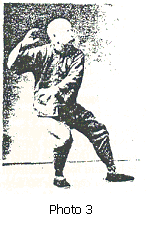 |
[Published in the T'ai Chi Magazine, Vol. 17, No. 3 JUNE 1993.]
Another Perspective on Historical Forms
By HERB GOLDBERG
I began studying T'ai Chi Ch'uan in 1976 with Master Lee Shiu Pak, a long time student of Master Chen Wei Ming. For this reason among others I would like to respond to Wu Ta-Yeh's article "Yang Chengfu's Earlier and Latest Taijiquan" in T'AI CHI, April 1993. (In doing so, it should be understood that I do not intend to judge or criticize the form of either Master Yang Cheng-Fu or Master Chen Wei Ming.)
A few years ago, I showed Yang Zhen Duo, Yang Cheng-Fu's son, a copy of Chen Wei Ming's 1925 book from which these photographs come. I asked him how old Yang Cheng-Fu was in the photographs. He said he was in his early thirties. Since he was born in 1883, the pictures would have been taken circa 1915.
There are two sets of pictures of Chen Wei Ming. The early set of photos that fit with Master Yang Cheng-Fu's were probably taken around 1915 as well. The other set of pictures of Chen Wei Ming, which were used in the previous article and also appear here, were taken many years later. The drawings of Yang Cheng-Fu were from approximately 1931. This information is simply for some historical perspective.
Lee Shiu Pak taught the wider stance and 45-degree back foot as discussed by Wu Ta Yeh, but I do not believe that the 45-degree back foot causes the difficulties described in the previous article, including leaning forward and knee hurting. Furthermore, I believe there art benefits to the appropriate use of the 45-degree back foot.
 |
 |
 |
Photo number 1 shows Yang Cheng-Fu with his back foot at 45 degrees and his knee appears to be over his foot. Photo number 2 shows his back foot at 90-80 degrees and his knee appears to be inside of his foot. Yet both of these photos show him to be leaning over. Photo 3 shows Chen Wei Ming circa 1925(?) with his back foot at approximately 45 degrees, the knee appears to be over the foot, and his torso seems to be upright. Also figure Al shows Yang Cheng-Fu circa 1931 with his back foot at about 90 degrees, his knee over his foot, and his torso leaning forward.
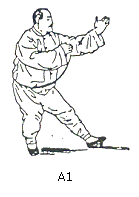
These photos would seem to refute the opinion that 80-90 degree back foot postures prevent leaning over and that 45 degree back foot postures cause it. I believe that the leaning is probably caused by how the pelvis is oriented, how flexible the back ankle is, how strong the legs are, the individual's sense of what upright is, and whether he intends to be upright at all.
In relation to knee injuries, I believe there is a greater risk of the knee not being over the foot in a back-weighted 80-90 degree stance than in a 45-degree one. If one places their knee inside of the foot, it is very likely that one's pelvis will also be in an incorrect position. (The knee position may misplace the hips and pelvis or vice versa.) This off-center position can place a great deal of strain over a period of time on the inside of the knee, possibly causing injury. Also, if one maintains his knee in this position and then steps or shifts weight onto the front leg while continuing to let the knee "buckle in," then particularly strong stress may be placed on the knee, possibly resulting in even greater injury.
Perhaps one of the reasons that the back-weighted foot is at 45 degrees is that most people may not be flexible enough in their pelvis and hips to keep their knee over their foot correctly while in a 90-degree back stance. The 45-degree position might reduce strain and the risk of injury.
In addition to the injuries caused by the knee buckling in, there may be two more causes. one was mentioned in the April article, when the knee of the forward weighted leg goes beyond the toes. The third, I believe, is when the individual, while stepping and prior to placing the foot onto the ground, continues to move the back knee excessively down and forward, this too, over time, may cause knee injury.
The previous article indicated that Chen Wei Ming's knee was hurting. Except for the most extreme cases, I think it is difficult to look at anybody's knee from a photograph and say that their knee is hurting or in a painful position. Many people can be in positions which others would find difficult, if not painful, to be in. I am not exactly sure why it hurts some people and not others, except perhaps some people are constructed in such a way that they we more supinated or more pronated in their feet, or they are bowlegged or knock-kneed, or more or less flexible, or stronger in a particular direction, etc. This allows them to be in these stances. So it would seem difficult to make an accurate judgement by simply looking at a photograph without knowing how the individual was constructed.
So far, the question has been about the angle of the back foot while back weighted. I think an examination of the back foot angle while front weighted will prove helpful. I believe there is a significant difference in the execution of the postures between whether the same hand and foot are forward (as in Single Whip Photo 4) or the opposite hand and foot are for ward (as in Fair Ladies Work the Shuttles Photo 5).
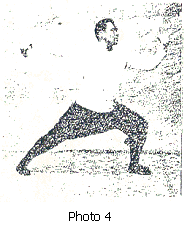
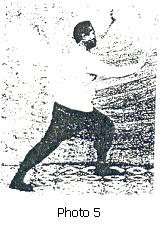
I think the difference dictates pelvis and foot placement. If one turns the foot out 80 or 90 degrees when one is trying to go onto a forward-weighted leg in an opposite hand/foot posture, there will be a pulling from the back of the foot up into the pelvis as one is trying to turn their pelvis face forward. If one's pelvis does not face forward, but faces on the other hand to the corner, one will be twisting their body up against the back foot creating stress and tension. By turning the foot 45 degrees in, this will alleviate the problem, more easily turning the pelvis, and more efficiently and quickly generate power. Even though I am skeptical, it may be that if one is extremely flexible then it could be possible for one's foot to be 80 degrees and be structured co rrectly.
One possible solution is if the foot has been opened 60 to 90 degrees to retreat, one can draw it in to perhaps 40 to 60 degrees when one is going into a forward opposite hand/foot posture, the reverse being true as well.
When one is going same hand/same foot forward, the back foot may remain about 80 degrees throughout the movement as the pelvis faces the corner. Examining the series of drawings of Yang Cheng-Fu (1931), it appears that his foot changes angles to suit the posture. Figure B1 shows his left foot at 45 degrees, then going to perhaps 80 degrees at figure B2, 90 degrees at figure B3, back to 80 degrees at figure B4 and then to 45 degrees at figure B5.

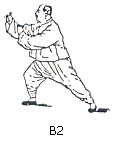
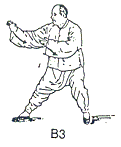
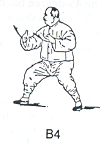
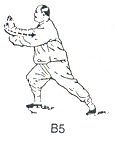
Figure C1 shows his left foot straight out. Figures C2 and C3 show it now at 45 degrees, weight back. There are many other examples of the rear foot being anywhere from 45 degrees to 90 degrees depending on the posture.

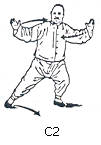

The previous article also discussed the change to higher stances. Higher stances may have more to do with ankle flexibility, leg strength, pelvis and back structure, the desire to feel "relaxed," and proper stepping than whether the foot is at 45 or 90 degrees. An increase of flexibility in the ankle as well as in the calf will allow for the knee to bend further down towards the floor, resulting in a lower and longer stance. As you go further down, your pelvis can move towards the center of the foot rather than the back of it, and you can with increased leg strength be lower while keeping your back straight.
In reference to Wu Ta-Yeh's conclusion about the Golden Cock Stands On One Foot posture, Photo 6 of Yang Cheng-Fu shows the knee and elbow touching and he is upright. This demonstrates that one need not bend over in order to touch the elbow and knee, Leaning over would then seem to be affected by how high the knee is and by whether the elbow is on the thigh, on the knee, or past the knee.
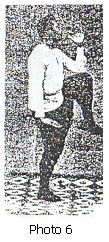
After studying with Lee Shiu Pak (who died a number of years ago), I organized and/or participated in numerous workshops with many teachers including T. T. Liang, Wei Lun Huang, Liang Shou Yu, Yang Zhen Duo, to name just a few. Perhaps the most important thing I've learned is that there are many different perspectives on doing the form and a lot to learn from all of them. For instance, some people teach turning while stepping is done on the forward weighted leg as I originally learned it from Master Lee Shiu Pak. Yet others teach moving the weight back first, then turning the foot out. I've worked with both ways, and I see benefits to both. It seems to me that the more tools in your toolbox that you know how to use, the better off you are. I think the answer to many questions of this type may be what another one of my teachers, Sam Slutsky, (one of Lee Shiu Pak's most senior instructors) said to me a number of times over the years, that it may not be this way or that way, but both.
In the previous article, it seems that Wu Ta-Yeh believed that Yang Chengfu's changes were in fact improvements in the art of T'ai Chi itself. How can we determine whether Yang Chengfu's form changes were improvements just for himself or for the art in general? I'm not sure that we could, I believe his form was affected by his size and shape relative to those around him. It seems obvious to me that being short or tall, fat or thin, physically strong or weak, etc., will affect the style of the individual's form. Yang Chengfu's developments may be appropriate for those of his proportions and construction. Perhaps they benefit all of us. But I think one has to be careful in reaching conclusions before specifying rules for everyone to follow.
I think it is at the worst dangerous, at the least pointless, and most likely against the nature of T'ai Chi to try to dictate such rigid limitations as "45 degrees always," "this wide, no more", "that high, no less", and that everyone should conform at all times.
I certainly think there are guidelines which have been and continue to be defined which help us learn the Way. But it also needs to be our way of doing T'ai Chi.
I think that whether something is 45 or 80 degrees is important, but far less so than how it feels. I think people need to have a better idea of how things feel. This is difficult because it is hard to find instructors who can help you with how it feels. I was lucky enough to have some teachers who could help me in this way.
I think that certain tests can be done to determine if something feels right or doesn't feel right. I believe that this kind of experimentation by the student can help them discover which of the various postures work best.
Some students will be able to do a posture better in one way while other students will be able to do that same posture better in a different way. I don't think both of those students should be required to do it in exactly the same way because their bodies may be dramatically different.
I believe that one has to simply open one's mind and one's body to experiment, to understand what is best for one's self at that particular time, and to let one's self be open for what will be best in the future.